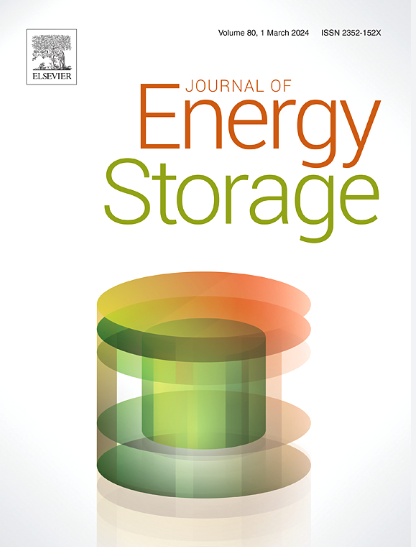Co掺杂提高了ZnFe2O4的初始利用率,提高了锂存储性能
IF 8.9
2区 工程技术
Q1 ENERGY & FUELS
引用次数: 0
摘要
尖晶石锌铁氧体(ZnFe2O4)通过多电子转移的锂化反应表现出较大的理论容量,该反应是不可逆的,在第一次充电后产生ZnO和Fe2O3。然而,由于ZnFe2O4的固有电导率较差,使其难以得到充分利用,导致比容量低于理论值。本文采用简单的水热法掺杂金属阳离子(Co),以提高ZnFe2O4在第一个循环中的利用率。密度泛函理论计算表明,Co掺杂可以改变ZnFe2O4的电子结构,使其对锂离子的吸附能增大。同时,Co掺杂在费米能级附近引入了新的电子态,降低了锂离子的迁移能垒,加快了电荷转移。电化学阻抗谱(EIS)表明,由于锂化反应动力学的改善,Co掺杂的ZnFe2O4在第一次循环中表现出更大的充放电容量,表明其具有更高的利用率。在随后的循环中也可以保持大容量。具体来说,Co掺杂ZnFe2O4(Co- zfo -5)在0.5 a g−1下循环200次后的比容量为839 mAh g−1,在1.0 a g−1下循环500次后的比容量为510 mAh g−1。本研究为进一步认识过渡金属氧化物阳极内在的结构-功能关系提供了基础。本文章由计算机程序翻译,如有差异,请以英文原文为准。

Co doping induced high initial utilization boosting Li storage performance of ZnFe2O4
Spinel zinc ferrite (ZnFe2O4) exhibits large theoretical capacity based on the lithiation reaction involving multi-electron transfer, which is irreversible and yield ZnO and Fe2O3 after the first recharging process. However, the poor intrinsic electrical conductivity of ZnFe2O4 make them difficult to be fully utilized, which leads to lower specific capacity compared with the theoretical value. In this work, metal cation (Co) doping is conducted by a simple hydrothermal method to enhance the utilization of ZnFe2O4 during the first cycle. Density functional theory calculations revealed that Co doping could alter the electronic structure of ZnFe2O4, resulting in larger adsorption energy of lithium ions. Meanwhile, Co doping introduces new electron state near the Fermi level, contributing to lower migration energy barrier of lithium ions and faster charge transfer. Benefiting from the improved lithiation reaction kinetics, as indicted by electrochemical impedance spectroscopy (EIS), Co doped ZnFe2O4 exhibits much larger discharge/charge capacity during the first cycle, suggesting its higher utilization. The large capacity could also be maintained in subsequent cycles. Specifically, Co doped ZnFe2O4(Co-ZFO-5) exhibits a specific capacity of 839 mAh g−1 after 200 cycles at 0.5 A g−1, and a specific capacity of 510 mAh g−1 after 500 cycles at 1.0 A g−1. This work provides a fundamental understanding to the intrinsic structure-function relationship of transition metal oxide anode.
求助全文
通过发布文献求助,成功后即可免费获取论文全文。
去求助
来源期刊

Journal of energy storage
Energy-Renewable Energy, Sustainability and the Environment
CiteScore
11.80
自引率
24.50%
发文量
2262
审稿时长
69 days
期刊介绍:
Journal of energy storage focusses on all aspects of energy storage, in particular systems integration, electric grid integration, modelling and analysis, novel energy storage technologies, sizing and management strategies, business models for operation of storage systems and energy storage developments worldwide.
 求助内容:
求助内容: 应助结果提醒方式:
应助结果提醒方式:


